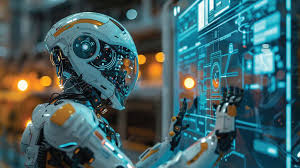The Rise of AI-Powered Robotics: Revolutionizing Automation

Introduction: The Synergy of AI and Robotics
In the last decade, artificial intelligence (AI) has fundamentally transformed the way we live, work, and interact with technology. One of the most exciting areas where AI is making a profound impact is robotics. Combining AI with robotics has opened up new avenues for automation, enhancing the ability of robots to learn, adapt, and make decisions in real-time. From autonomous vehicles to intelligent factory robots, AI-powered robotics is revolutionizing industries and redefining the boundaries of what machines can achieve.
AI in Robotics: How It Works
At its core, AI allows robots to process and interpret data, learn from it, and make decisions. Traditional robots were programmed to follow a set of predetermined instructions. In contrast, AI-powered robots use algorithms that enable them to sense their environments, analyze complex patterns, and act autonomously based on the data they collect.
There are a few key AI technologies that are central to the rise of robotics:
- Machine Learning (ML): ML enables robots to improve their performance over time by learning from data. Instead of being explicitly programmed, robots can analyze their experiences and adjust their actions to achieve better results.
- Computer Vision: This technology allows robots to 'see' their surroundings. By processing images from cameras or sensors, robots can identify objects, navigate environments, and understand visual cues.
- Natural Language Processing (NLP): NLP enables robots to understand and respond to human speech, making communication with machines more intuitive and natural.
- Deep Learning: Deep learning models are helping robots tackle more complex tasks, from recognizing emotions to performing highly sophisticated operations in dynamic environments.
Real-World Applications of AI-Powered Robotics
1. Manufacturing and Industrial Automation
AI-driven robotics has transformed the manufacturing landscape. Robots equipped with machine learning algorithms and computer vision systems can carry out complex tasks, such as assembly, quality inspection, and predictive maintenance, with minimal human intervention. For example, collaborative robots (cobots) work alongside humans in factories, enhancing productivity and safety.
2. Healthcare and Surgical Robotics
In healthcare, AI-powered robots are playing a critical role in enhancing patient care. Surgical robots, guided by AI, assist doctors in performing minimally invasive surgeries with extreme precision. These robots analyze data from patient scans to provide real-time insights during procedures, reducing errors and recovery times. AI is also being used in robotic systems for tasks like patient monitoring, medication dispensing, and rehabilitation.
3. Autonomous Vehicles and Drones
The development of autonomous vehicles relies heavily on AI-powered robotics. Self-driving cars and delivery drones use AI to navigate through complex environments, make split-second decisions, and avoid obstacles. These autonomous systems gather data from sensors, such as LiDAR and cameras, and use machine learning models to continuously improve their navigation and safety capabilities.
4. Logistics and Supply Chain Management
In logistics, AI-powered robots are streamlining processes such as sorting, packing, and delivery. Automated warehouses, like those of Amazon and Alibaba, deploy robots to fulfill orders at speeds far beyond human capability. Additionally, autonomous delivery robots and drones are being used to handle the last-mile delivery process, reducing human labor and transportation costs.
Future Prospects: AI-Powered Robotics in Everyday Life
As AI continues to evolve, its integration into robotics will become even more sophisticated. Here are some future prospects for AI-powered robotics:
- Human-Robot Collaboration: Robots will become more collaborative, working seamlessly with humans in various settings, from factories to households. With advances in AI, these robots will be able to understand and anticipate human needs, improving efficiency and user experience.
- Smart Homes and Personal Robots: AI-powered personal robots may soon become part of everyday life. These robots could assist with household chores, provide companionship, and even offer healthcare support to the elderly and disabled.
- Robotics in Agriculture: Autonomous farming robots, driven by AI, are expected to play a key role in precision agriculture. These robots can monitor crop health, optimize irrigation, and harvest produce, addressing challenges such as labor shortages and food security.
Challenges and Ethical Considerations
While the rise of AI-powered robotics presents tremendous opportunities, it also raises important challenges and ethical concerns:
- Job Displacement: As robots take over more jobs traditionally done by humans, there is growing concern about job displacement in sectors like manufacturing and logistics. There will be a need for policies to ensure a smooth transition for workers affected by automation.
- Bias in AI Algorithms: AI algorithms are only as good as the data they are trained on. If the data is biased, robots may make biased or unfair decisions, particularly in sensitive applications like healthcare or law enforcement.
- Safety and Regulation: Ensuring the safety of AI-powered robots is critical, especially when they operate in close proximity to humans. Regulatory frameworks will need to evolve to address safety, liability, and accountability in cases where AI systems fail or cause harm.
Conclusion: A New Era of Robotics
The combination of AI and robotics is ushering in a new era of automation, with the potential to revolutionize nearly every industry. From smart factories to autonomous vehicles, AI-powered robots are becoming more intelligent, adaptive, and capable than ever before. While there are challenges to navigate, the benefits of this technology are vast and will continue to shape the future of innovation, productivity, and everyday life. As AI continues to evolve, the boundary between machines and humans will blur, leading to more profound and meaningful human-robot collaboration in the years to come.